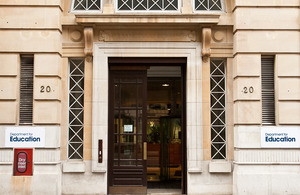Performance tables: only the highest quality qualifications to be included
Announcement that qualifications counting in performance pables will be reduced from 3,175 to 125.

-
‘Equivalent’ qualifications to be slashed from more than 3,175 to just 125.
-
All qualifications will have the same value in the tables.
Only the very highest quality qualifications will be included in future secondary school performance tables, the Department for Education announced today.
The announcement follows recommendations made in a report by Professor Alison Wolf last year. She highlighted how the current Performance Table system creates perverse incentives for some schools to put pupils on courses which might boost their Performance Table positions - but are not qualifications which benefit pupils’ prospects.
At the moment there are 3,175 so-called equivalent qualifications accredited and approved for study by 14- to 16-year-olds, all of which count in the tables. Under the last government some of these were worth as much as four, five or even six GCSEs.
But from the 2014 Performance Tables (published in January 2015), just 125 of these qualifications (3.9 per cent of the current total) will count. Full-course GCSEs, established iGCSEs, AS levels and music exams at grade six and above will also be included. All will be included on the same one-for-one basis.
The Secretary of State for Education, Michael Gove, said the changes would extend opportunity because only qualifications which had demonstrated rigour and had track records of taking young people into good jobs and university would count in future.
He highlighted how the number of so-called equivalent qualifications achieved by pupils up to age 16 had exploded in recent years - from 15,000 in 2004 to 575,000 in 2010.
Of the 125 to be included, 70 can count towards a school’s main Performance Table measure - the proportion of pupils who get five A* to C GCSE grades. The other 55 are qualifications which cannot contribute to the five A* to C measure.
Some of the qualifications included are subject to future review. This is because they have demonstrated they have most but not all of the necessary characteristics or because they are too new to demonstrate a track record. They are being given an extra year to do this.
Schools will remain free to offer any other qualification accredited and approved for study by 14- to 16-year-olds. Teachers will still be able to use their professional judgment to offer the qualifications which they believe are right for their pupils. But only those meeting the Department’s rigorous requirements will count in Performance Tables. Focusing Performance Tables on the qualifications which benefit pupils’ prospects will also free up time for a more balanced curriculum.
Education Secretary Michael Gove said:
The weaknesses in our current system were laid bare by Professor Wolf’s incisive and far-reaching review. The changes we are making will take time but will transform the lives of young people.
For too long the system has been devalued by attempts to pretend that all qualifications are intrinsically the same. Young people have taken courses that have led nowhere.
Prof Alison Wolf said:
Vocational studies can form a stimulating and demanding part of the curriculum.
But pretending that all vocational qualifications are equally valuable does not bring them respect. On the contrary, it devalues vocational education in people’s eyes.
I am delighted that the Government has implemented my recommendations in this area, and is rebalancing its league tables in ways that will promote high quality vocational qualifications.
Following Prof Wolf’s review, the Department for Education consulted on proposals which set out the characteristics that qualifications needed to have to be included in the headline measures of the school performance tables.
The characteristics of high-quality qualifications, as set out in the Government consultation, are that:
- they offer pupils proven progression into a broad range of further qualifications or careers post-16, rather than narrowing students’ options
- they are the size of a GCSE or bigger
- they have a substantial proportion of external assessment and require students to use knowledge across their subject
- they have grades such as A*-G (those with simple pass or fail results will be excluded)
- they have good levels of take-up among 14- to 16-year-olds, if taught for at least two years
Additionally, 12 new studio schools are approved to open later this year, joining six already open. Thirteen new University Technical Colleges (UTCs) are also approved to open from September 2012 onwards. UTCs are academies for 14- to 19-year-olds, focusing on providing technical education that meets the needs of modern business. They offer full-time courses, which focus on technical specialisms and academic studies.
Notes to editors:
-
A copy of the Government response to the consultation on qualifications is available on our website.
-
A copy of Professor Alison Wolf’s report is available on our website.
-
There is a full list of the qualifications that will be included from the 2014 Performance Tables (published in January 2015).
DfE media enquiries
Central newsdesk - for journalists 020 7783 8300